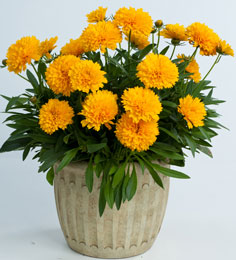10/29/2013
Crazy for Coreopsis
Chanochi Zaks

Ever-popular coreopsis offers a virtually endless palette of possibilities for consumer and garden appeal alike. With both perennials and annuals to choose from, opportunities abound for all climates and settings.
Varieties such as Coreopsis Solanna Golden Sphere provide early repeated color in the form of large, fully double yellow blooms. Plants form nice, compact mounds and bloom continuously from early summer through fall. Golden Sphere prefers full sun and tolerates heat and humidity well. It grows to about 12 in. and is hardy in Zones 5 to 9. Golden Sphere is great in borders and containers and attractive to butterflies. It’s also excellent as a cut flower.
On the annual side, well-branching series like
Coreopsis hybrida Highland and Prairie provide beautiful bursts of striking color. Semi vigorous, the Highland series blooms profusely and continuously starting in early spring. Blast has large, rich red flowers that feature a bright yellow rim; Burgundy offers striking dark pink flowers with light pink rims; Honey is a soft yellow with dark centers; and Gold lives up to its name. Also well branching, Prairie varieties form lovely compact mounds. Colors include Amber, a striking orange-maroon; Gold, a rich yellow with dark centers; and White, with reddish-maroon centers inside snowy white petals. Both series are ideal for gardens, patio pots and mixed containers.
Rooting and planting
Plant Golden Sphere one liner per 1 qt. or 1 gal. pot. For Highland Blast and Prairie, stick one liner per 1 gal. or larger pot. Use a medium with good drainage.
Root for three weeks at 72 to 74F (22 to 23C). In the third week, lower to 68F (20C). Mist with 50 ppm nitrogen in Weeks 1 and 2. In week 3, pinch. Feed 150 ppm nitrogen.
Maintain pH at 6.0 to 6.5 and keep electrical conductivity (EC) at 0.8 for Week 1 and 0.8 to 0.9 for Week 2.
At liner planting and again at Week 2, drench with a broad-spectrum fungicide such as Daconil. Golden Sphere will finish in approximately five to seven weeks; Highland Blast and Prairie in approximately eight weeks.
Media
Choose a well-drained, fertile growing medium.
pH and Electrical Conductivity
Maintain pH at 6.0 to 6.5 and keep electrical conductivity (EC) at 0.9 to 1.0 for Weeks 3 and beyond.
Temperatures
Provide temperatures approximately 72 to 74F (22 to 23C) to Week 3 and keep greenhouses at 62 to 65F (16 to 18C) from Weeks 4 through 14. Maintain night temperatures at 55 to 65F (13 to 18C).
Light requirements
Coreopsis prefers full sun and bright light. Golden Sphere flowers early without light manipulation. Supplemental lighting is beneficial for other varieties.
Pinching and plant growth regulators
Pinch at Week 3. Apply a B-Nine and A-Rest tank mix at Weeks 4 to 14. Consider drenching finished containers with 2 ppm Bonzi if needed.
Fertilizer
Coreopsis requires only moderate fertilization. Feed 100 to 150 ppm nitrogen from Week 3 until finish. Leach with clear water as needed to avoid fertilizer salt buildup.
Irrigation
Prevent root damage by avoiding overwatering. Keep plants evenly moist.
Pest control
Maintain a preventive program that includes good air circulation and moderate humidity levels. Monitor and scout vigilantly to prevent disease or insect activity.
Insects typically aren’t a problem with proper environment management. Monitor for diseases, including botrytis, particularly with tight spacing and overhead irrigation, and powdery mildew, which can appear due to the cool, wet environment. Use a fungicide labeled for the prevention of powdery mildew.
For more information on Coreopsis or any of Danziger’s products, call (972) 3-9602525, e-mail
danziger@danziger.co.il or visit
www.danziger.co.il.
GT
Chanochi Zaks is vice president of marketing for Danziger "Dan" Flower Farm. He can be reached at chanochi@danziger.co.il.